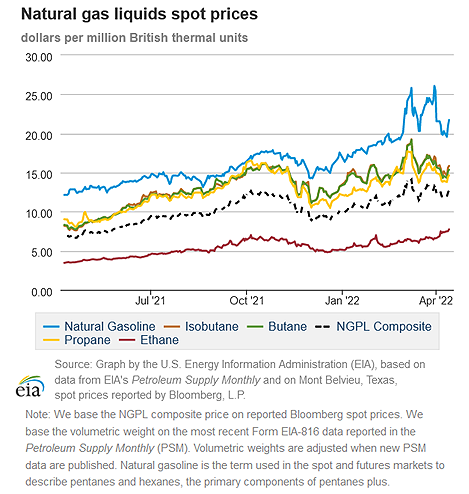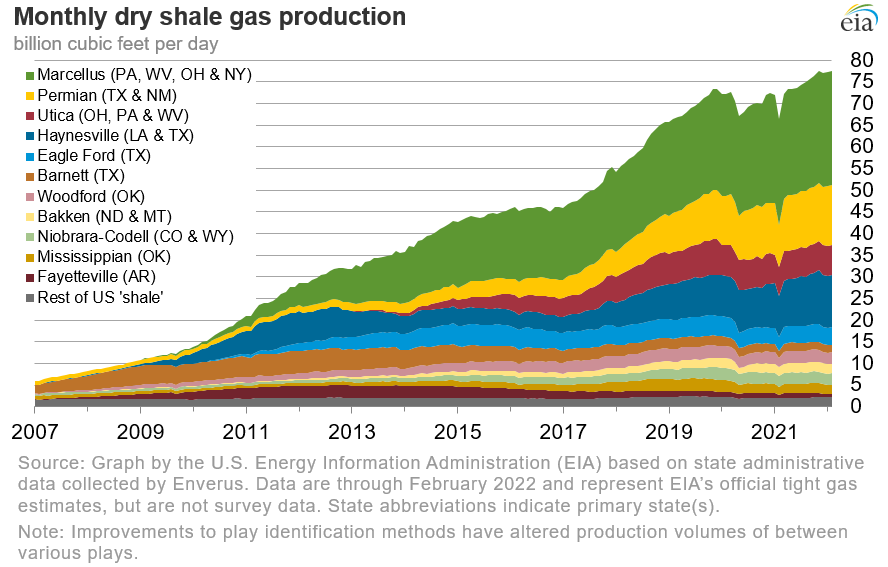In the News:
Net withdrawals from working gas stocks exceeded the five-year average during the 2020–21 heating season
Working natural gas in underground storage facilities in the Lower 48 states totaled nearly 1,387 billion cubic feet (Bcf) as of March 31, 2022—the end of the winter heating season (November–March). This level was 16.8% lower than the five-year average (2017-21), according to EIA’s Weekly Natural Gas Storage Report, released on April 7. Net withdrawals from working natural gas inventories during the 2020–21 heating season exceeded the five-year average by 9.7%.
Following a slow start to the 2021–22 heating season, a sustained period of colder-than-normal temperatures throughout much of the Lower 48 states, beginning in January 2022, contributed to high natural gas demand in the residential and commercial sectors for space heating and to increased demand for natural gas in the electric power sector. Natural gas consumption in the residential, commercial, and electric power sectors combined was 3.4 billion cubic feet per day (Bcf/d) (5.6%) higher than the 2020–21 heating season, according to PointLogic. Liquefied natural gas (LNG) deliveries also increased during the 2021–22 heating season, exceeding last year’s level by 1.8 Bcf/day (18.4%). These increases in natural gas demand during the heating season more than offset the 4.5 Bcf/d increase in natural gas production over year-ago levels.
Working natural gas inventories went from a deficit to the five-year average to a surplus and then back to a deficit during the 2021–22 heating season. Working gas inventories entered the 2021–22 heating season at a slight deficit to the five-year average, but relatively mild temperatures in December mitigated withdrawal activity and left inventories with a modest surplus to the five-year average by the end of the month. However, this surplus was short-lived when colder-than-normal temperatures moved into the Lower 48 states in January, which increased heating demand for natural gas and withdrawals from storage. As a result, working natural gas inventories again fell below the five-year average in January. Since the beginning of the year, net withdrawals from working natural gas exceeded the five-year average in 10 out of 13 weeks, and working natural gas inventories went from a surplus of 96 Bcf as of December 31, 2021, to a deficit of 285 Bcf by April 1, 2022.
Net withdrawals from underground storage facilities in the Lower 48 states during January 2022 totaled 991 Bcf—the largest draw for January since 2012—and exceeded the five-year average withdrawal for the month by 292 Bcf. Net withdrawals during January accounted for about 44% of all withdrawals from natural gas storage during the 2021-22 heating season, compared with 35% over the previous five heating seasons. In January 2022, population-weighted heating degree days (HDDs) were 9% higher than normal, which drove the higher-than-normal withdrawals.
See EIA’s Natural Gas Storage Dashboard for more updates on the storage market conditions.
Overview:
(For the week ending Wednesday, April 13, 2022)
- Spot prices: Natural gas spot prices rose at most locations this report week (Wednesday, April 6 to Wednesday, April 13). The Henry Hub spot price rose from $6.25 per million British thermal units (MMBtu) last Wednesday to $6.70/MMBtu yesterday.
- International spot prices: International natural gas spot prices declined this report week but have remained elevated since the start of Russia’s further invasion of Ukraine on February 24, which has increased uncertainty in European natural gas markets. Bloomberg Finance, L.P. reports that swap prices for liquefied natural gas (LNG) cargoes in East Asia fell $0.83/MMBtu to a weekly average of $33.22/MMBtu. At the Title Transfer Facility (TTF) in the Netherlands, the most liquid natural gas spot market in Europe, the day-ahead prices fell $3.33 to a weekly average of $32.84/MMBtu. TTF prices averaged lower than East Asia spot prices this week after two consecutive weeks higher than East Asia prices. In the same week last year (week ending April 14, 2021), prices in East Asia and at the TTF were $6.99/MMBtu and $7.03/MMBtu, respectively.
- Futures: The price of the May 2022 NYMEX contract increased 96.8 cents, from $6.029/MMBtu last Wednesday to $6.997/MMBtu yesterday. The price of the 12-month strip averaging May 2022 through April 2023 futures contracts climbed 92.9 cents to $6.958/MMBtu.
- Storage: The net injections to working gas totaled 15 billion cubic feet (Bcf) for the week ending April 8. Working natural gas stocks totaled 1,397 Bcf, which is 24% lower than the year-ago level and 18% lower than the five-year (2017–2021) average for this week.
- NGPLs: The natural gas plant liquids (NGPLs) composite price at Mont Belvieu, Texas, fell by 23 cents/MMBtu, averaging $12.22/MMBtu for the week ending April 13. Natural gas prices at the Houston Ship Channel increased by 10%, while the ethane price rose 8%. The ethane premium to natural gas narrowed by 1%. The ethylene premium over ethane remained relatively unchanged week over week. The Brent crude oil price decreased by 3%, pulling down the prices of propane, butanes, and natural gasoline. The propane and isobutane prices fell by 4%. The price of normal butane fell by 5% and the price of natural gasoline fell by 7%. The propane discount to crude oil widened by 3%.
- Rigs: According to Baker Hughes, for the week ending Tuesday, April 5, the natural gas rig count was up by 3 rigs from a week ago at 141 rigs. The Haynesville, the Utica, and an unspecified location each added one rig. The natural gas-directed rig count is at its highest level since October 11, 2019. The number of oil-directed rigs increased by 13 to 546 rigs. The Permian added nine rigs, and one rig each was added in the DJ Niobrara, the Eagle Ford, the Williston, and an unspecified location. The total rig count now stands at 689, the highest level since March 27, 2020, and 257 rigs more than the same week last year.
Prices/Supply/Demand:
Prices along the Gulf Coast increase with temperatures. This report week (Wednesday, April 6 to Wednesday, April 13), the Henry Hub spot price rose 46 cents from $6.24/MMBtu last Wednesday to $6.70/MMBtu yesterday. Prices along the Gulf Coast and Southeast were all higher this report week, in line with the Henry Hub spot price and the May NYMEX Henry Hub futures contract. Natural gas consumption along the Gulf Coast increased 0.3 billion cubic feet per day (Bcf/d) (2%), according to PointLogic. The increase was almost entirely due to increased demand by the electric power generation sector in the South Texas region, which had higher-than-normal temperatures toward the end of the report week. Feedgas deliveries to liquefied natural gas (LNG) export terminals along the Gulf Coast decreased by 0.1 Bcf/d (1%) to 11.2 Bcf/d this report week. According to Freeport LNG, the terminal has started its first major planned maintenance turnaround on Train 1, which is anticipated to last 18 days. Natural gas deliveries to the terminal on both the Gulf South and Texas Eastern pipelines decreased on April 5, indicating maintenance may be completed on or around April 21.
Prices in the West increase with mixed weather along the coast. The price at PG&E Citygate in Northern California rose 82 cents, up from $6.85/MMBtu last Wednesday to $7.67/MMBtu yesterday. The price at Malin, Oregon, the northern delivery point into the PG&E service territory, increased 73 cents, up from $5.94/MMBtu last Wednesday to $6.67/MMBtu yesterday. The price at Sumas on the Canada-Washington border, the main pricing point for the Pacific Northwest, rose 68 cents, up from $5.86/MMBtu last Wednesday to $6.54/MMBtu yesterday. Natural gas consumption in the Pacific Northwest by the residential and commercial sectors increased 0.2 Bcf/d (22%) this report week, and natural gas consumption by the electric power generation sector increased 0.2 Bcf/d (30%), according to data from PointLogic. Temperatures in the Seattle City Area averaged 47°F this report week, 3°F lower than normal. On Tuesday, temperatures in the Seattle City Area reached an overnight low of 35°F, the lowest temperature since March 10, leading to 23 heating degree days (HDD), 8 more than normal.
Prices in the Rocky Mountain region rose above the national average this report week. A winter storm entered the Northwest and moved into the Rockies and Northern Plains regions, bringing lower temperatures and snow. The price at Opal in Southwest Wyoming, the main trading point for natural gas in the Rocky Mountain region and the origin point for deliveries into the California market through the Ruby Pipeline, increased 56 cents from $5.95/MMBtu last Wednesday to $6.51/MMBtu yesterday. The price at SoCal Citygate in Southern California increased 63 cents, up from $6.28/MMBtu last Wednesday to $6.91/MMBtu yesterday. In California, natural gas demand in the electric power generation sector increased 0.4 Bcf/d (40%) this report week, according to data from PointLogic. Temperatures in the Riverside Area, inland from Los Angeles, averaged 68°F, which is 6°F higher than normal. On Friday, April 8, temperatures in the Riverside Area reached a high of 100°F, leading to 15 cooling degree days (CDD), 14 more than normal and the highest on record.
Prices in the Northeast are mixed this week but remain elevated. At the Algonquin Citygate, which serves Boston-area consumers, the price went down 13 cents from $6.39/MMBtu last Wednesday to $6.26/MMBtu yesterday. At the Transcontinental Pipeline Zone 6 trading point for New York City, the price decreased 4 cents from $6.25/MMBtu last Wednesday to $6.21/MMBtu yesterday. Temperatures in the Northeast were within seasonal normals this week and total natural gas consumption declined 2.0 Bcf/d (11%) to average 16.3 Bcf/d, according to PointLogic. Consumption in the residential and commercial sectors decreased 1.6 Bcf/d (18%) to average 6.9 Bcf/d. Prices in the Northeast were mixed, however, and rose in other regional pricing hubs week over week. All prices in Zones 5 and 6 along the Tennessee Gas Pipeline system (Tenn Zone 5 and Tenn Zone 6) were higher this week. Tenn Zone 6 200L, which serves New England customers, rose 19 cents from $6.36/MMBtu last Wednesday to $6.55/MMBtu yesterday. Tennessee Gas Pipeline announced system-wide restrictions (Notice ID: 382549) in advance of the weekend in anticipation of milder temperatures and less demand.
Prices in the Appalachia production region increase amid tight market fundamentals. The Tennessee Zone 4 Marcellus spot price increased 3 cents from $5.93/MMBtu last Wednesday to $5.96/MMBtu yesterday. The price at Eastern Gas South in southwest Pennsylvania rose 14 cents from $5.95/MMBtu last Wednesday to $6.09/MMBtu yesterday. Natural gas production decreased week over week by 0.2 Bcf/d (1%) to average 33.3 Bcf/d, and net flows out of the region declined by 0.5 Bcf/d to average 25.1 Bcf/d, according to PointLogic. Tennessee Gas Pipeline announced system-wide restrictions ahead of the weekend (the Northeast section includes additional information).
Prices in the Permian production region rise but by less than the Henry Hub price. The price at the Waha Hub in West Texas, which is located near Permian Basin production activities, rose 33 cents this report week, from $5.74/MMBtu last Wednesday to $6.07/MMBtu yesterday. The Waha Hub traded 63 cents below the Henry Hub price yesterday, compared with last Wednesday when it traded 51 cents below the Henry Hub price. Natural gas production was relatively flat this week, decreasing by less than 0.1 Bcf/d (1%) to average 14.6 Bcf/d, according to PointLogic. The decrease was primarily in the New Mexico side of the Permian Basin producing area. Net natural gas flows out of the Permian Basin and West Texas region, at 13.4 Bcf/d and 9.8 Bcf/d, respectively, were relatively flat week over week. The Double E Pipeline, operated by Summit Midstream Partners, LP, is reportedly undergoing a maintenance event at the receipt point of the Lucid Road Runner natural gas processing plant in Eddy County, New Mexico. This maintenance resulted in reduced volumes of processed natural gas delivered into the pipeline by approximately 160 million cubic feet per day (MMcf/d).
U.S. total supply of natural gas declines slightly this week. The average total supply of natural gas fell slightly this week compared with the previous report week, according to data from PointLogic. Dry natural gas production decreased by 0.1% (0.1 Bcf/d) compared with the previous report week, and average net imports from Canada were relatively unchanged week over week.
U.S. consumption of natural gas is down across most sectors this week. U.S. consumption of natural gas fell by 2.9% (2.1 Bcf/d) compared with the previous report week, according to data from PointLogic. The only increase in natural gas consumption was in the electric power sector, which rose by 1.4% (0.4 Bcf/d) week over week. Consumption in the industrial sector and residential and commercial sectors decreased by 0.7% (0.2 Bcf/d) and 9.8% (2.3 Bcf/d), respectively. Natural gas exports to Mexico decreased 1.8% (0.1 Bcf/d), and natural gas deliveries to U.S. LNG export facilities (LNG pipeline receipts) averaged 12.4 Bcf/d, or 0.1 Bcf/d lower than last week.
U.S. LNG exports decrease by four vessels this week from last week. Twenty LNG vessels (six from Sabine Pass; four each from Cameron and Corpus Christi; three from Freeport; two from Calcasieu Pass; and one from Cove Point) with a combined LNG-carrying capacity of 75 Bcf departed the United States between April 7 and April 13, according to shipping data provided by Bloomberg Finance, L.P. Bad weather in the Gulf of Mexico, which included elevated winds and waves of up to 7 feet, in addition to planned maintenance, resulted in lower LNG shipments this week. Correction: For report week March 30 to April 6, one more cargo than was reported departed Cove Point for a total of 24 vessels and a combined carrying capacity of 89 Bcf departing the United States that week.
Storage:
The net injections into storage totaled 15 Bcf for the week ending April 8, compared with the five-year (2017–2021) average net injections of 33 Bcf and last year's net injections of 55 Bcf during the same week. Working natural gas stocks totaled 1,397 Bcf, which is 303 Bcf lower than the five-year average and 439 Bcf lower than last year at this time.
According to The Desk survey of natural gas analysts, estimates of the weekly net change to working natural gas stocks ranged from net injections of 5 Bcf to 29 Bcf, with a median estimate of 21 Bcf.
More storage data and analysis can be found on the Natural Gas Storage Dashboard and the Weekly Natural Gas Storage Report.
See also:
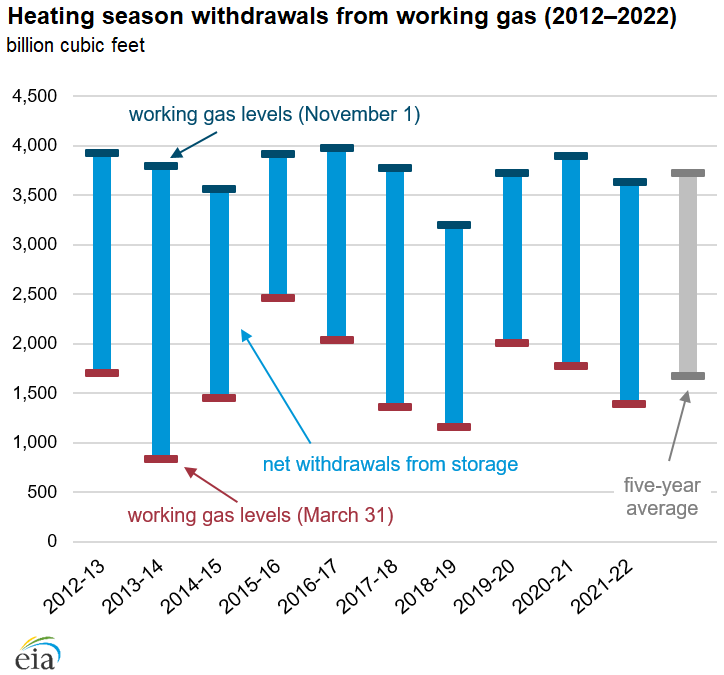 Source: U.S. Energy Information Administration, Natural Gas Monthly and Weekly Natural Gas Storage Report
Source: U.S. Energy Information Administration, Natural Gas Monthly and Weekly Natural Gas Storage Report Note: Data for March 31, 2022, is an interpolated value, based on the Weekly Natural Gas Storage Report.
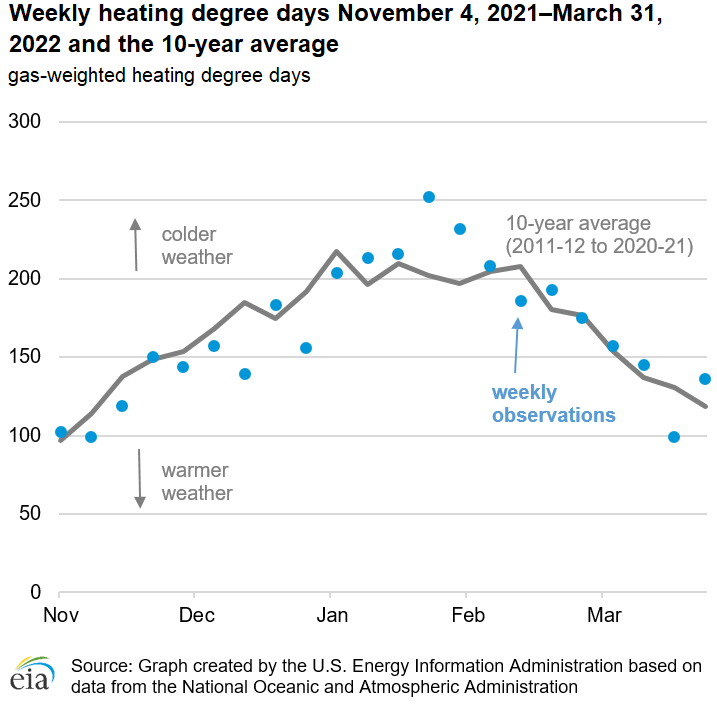
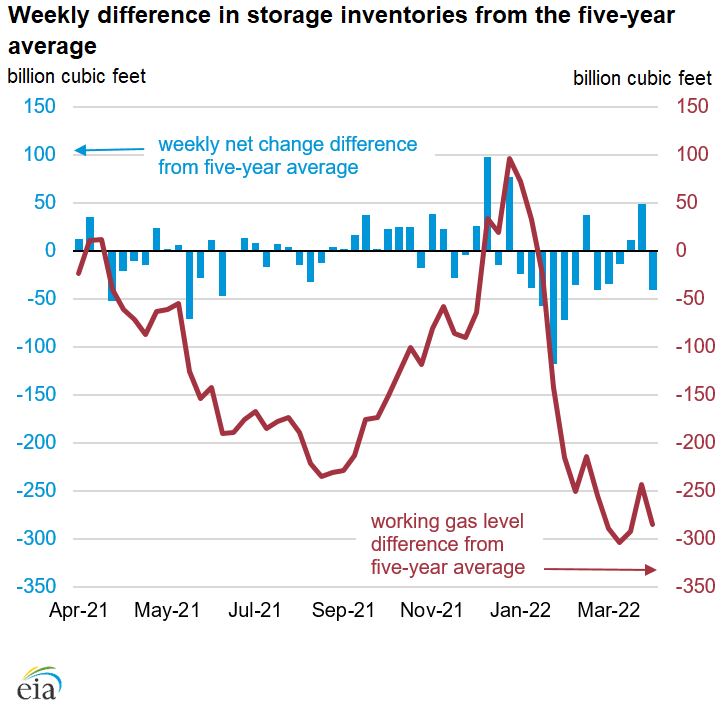 Source: U.S. Energy Information Administration, Weekly Natural Gas Storage Report
Source: U.S. Energy Information Administration, Weekly Natural Gas Storage Report
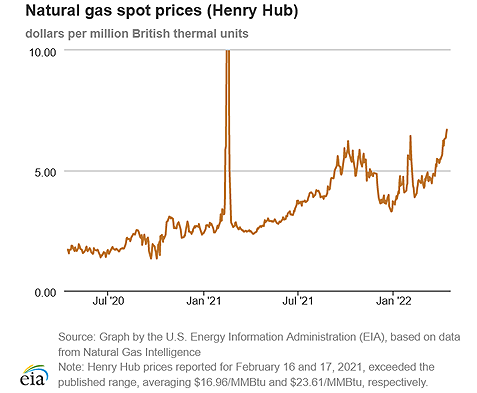
| Spot Prices ($/MMBtu) | Thu, 07-Apr |
Fri, 08-Apr |
Mon, 11-Apr |
Tue, 12-Apr |
Wed, 13-Apr |
|---|---|---|---|---|---|
| Henry Hub |
6.03 |
6.30 |
6.36 |
6.56 |
6.70 |
| New York |
5.86 |
5.96 |
6.09 |
6.09 |
6.21 |
| Chicago |
6.02 |
6.09 |
6.40 |
6.50 |
6.70 |
| Cal. Comp. Avg.* |
6.18 |
6.21 |
6.79 |
7.08 |
7.02 |
| Futures ($/MMBtu) | |||||
| May contract | 6.359 |
6.278 |
6.643 |
6.680 |
6.997 |
| June contract |
6.436 |
6.356 |
6.723 |
6.763 |
7.096 |
|
Sources: Natural Gas Intelligence and CME Group as compiled by Bloomberg, L.P. |
|||||
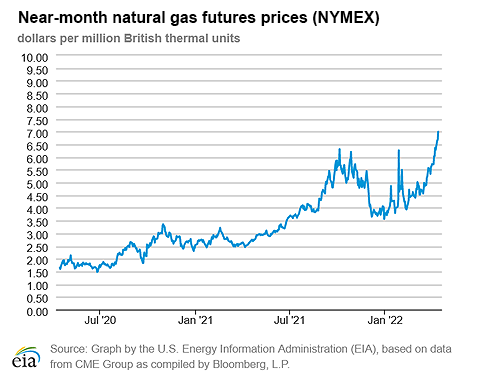
| U.S. natural gas supply - Gas Week: (4/7/22 - 4/13/22) | |||
|---|---|---|---|
Average daily values (billion cubic feet) |
|||
this week |
last week |
last year |
|
| Marketed production | 107.0 |
107.2 |
105.3 |
| Dry production | 94.9 |
95.0 |
92.9 |
| Net Canada imports | 5.6 |
5.6 |
3.7 |
| LNG pipeline deliveries | 0.1 |
0.1 |
0.1 |
| Total supply | 100.5 |
100.7 |
96.6 |
|
Source: Chart by the U.S. Energy Information Administration (EIA), based on data from PointLogic | |||
| U.S. natural gas consumption - Gas Week: (4/7/22 - 4/13/22) | |||
|---|---|---|---|
Average daily values (billion cubic feet) |
|||
this week |
last week |
last year |
|
| U.S. consumption | 70.1 |
72.2 |
61.6 |
| Power | 26.3 |
25.9 |
24.5 |
| Industrial | 23.0 |
23.1 |
21.8 |
| Residential/commercial | 20.9 |
23.1 |
15.3 |
| Mexico exports | 5.8 |
5.9 |
6.4 |
| Pipeline fuel use/losses | 6.5 |
6.6 |
6.2 |
| LNG pipeline receipts | 12.4 |
12.5 |
11.2 |
| Total demand | 94.8 |
97.1 |
85.4 |
|
Source: Chart by the U.S. Energy Information Administration (EIA), based on data from PointLogic | |||
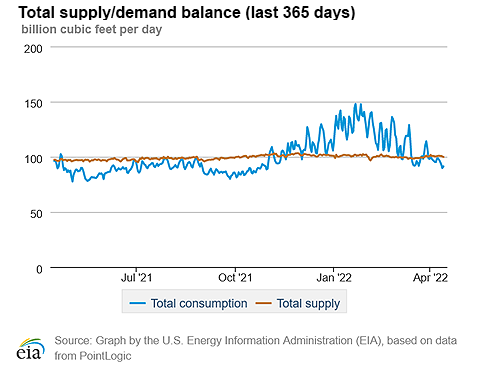
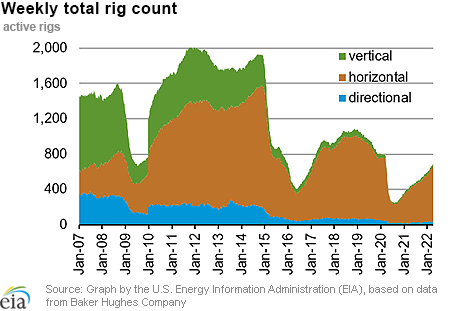
| Rigs | |||
|---|---|---|---|
Tue, April 05, 2022 |
Change from |
||
last week |
last year |
||
| Oil rigs | 546 |
2.4% |
62.0% |
| Natural gas rigs | 141 |
2.2% |
51.6% |
| Note: Excludes any miscellaneous rigs | |||
| Rig numbers by type | |||
|---|---|---|---|
Tue, April 05, 2022 |
Change from |
||
last week |
last year |
||
| Vertical | 26 |
4.0% |
30.0% |
| Horizontal | 631 |
2.9% |
60.2% |
| Directional | 32 |
-8.6% |
77.8% |
| Source: Chart by the U.S. Energy Information Administration (EIA), based on data from Baker Hughes Company | |||
| Working gas in underground storage | ||||
|---|---|---|---|---|
Stocks billion cubic feet (Bcf) |
||||
| Region | 2022-04-08 |
2022-04-01 |
change |
|
| East | 229 |
241 |
-12 |
|
| Midwest | 293 |
296 |
-3 |
|
| Mountain | 90 |
91 |
-1 |
|
| Pacific | 169 |
165 |
4 |
|
| South Central | 617 |
589 |
28 |
|
| Total | 1,397 |
1,382 |
15 |
|
|
Source: U.S. Energy Information Administration Form EIA-912, Weekly Underground Natural Gas Storage Report | ||||
| Working gas in underground storage | |||||
|---|---|---|---|---|---|
Historical comparisons |
|||||
Year ago (4/8/21) |
5-year average (2017-2021) |
||||
| Region | Stocks (Bcf) |
% change |
Stocks (Bcf) |
% change |
|
| East | 310 |
-26.1 |
281 |
-18.5 |
|
| Midwest | 412 |
-28.9 |
372 |
-21.2 |
|
| Mountain | 118 |
-23.7 |
100 |
-10.0 |
|
| Pacific | 204 |
-17.2 |
185 |
-8.6 |
|
| South Central | 794 |
-22.3 |
763 |
-19.1 |
|
| Total | 1,836 |
-23.9 |
1,700 |
-17.8 |
|
| Source: U.S. Energy Information Administration Form EIA-912, Weekly Underground Natural Gas Storage Report | |||||
| Temperature – heating & cooling degree days (week ending Apr 07) | ||||||||
|---|---|---|---|---|---|---|---|---|
HDDs |
CDDs |
|||||||
| Region | Current total |
Deviation from normal |
Deviation from last year |
Current total |
Deviation from normal |
Deviation from last year |
||
| New England | 143 |
-16 |
-7 |
0 |
0 |
0 |
||
| Middle Atlantic | 139 |
-4 |
6 |
0 |
0 |
0 |
||
| E N Central | 161 |
14 |
52 |
0 |
0 |
-1 |
||
| W N Central | 158 |
16 |
70 |
0 |
-1 |
-2 |
||
| South Atlantic | 73 |
-2 |
-16 |
23 |
10 |
15 |
||
| E S Central | 79 |
9 |
-7 |
2 |
-3 |
1 |
||
| W S Central | 29 |
-8 |
-9 |
28 |
13 |
10 |
||
| Mountain | 118 |
-12 |
36 |
7 |
2 |
-4 |
||
| Pacific | 49 |
-27 |
0 |
3 |
1 |
3 |
||
| United States | 109 |
-3 |
19 |
8 |
4 |
4 |
||
|
Source: Chart by the U.S. Energy Information Administration (EIA), based on data from the National Oceanic and Atmospheric Administration Note: HDDs=heating degree days; CDDs=cooling degree days | ||||||||
Average temperature (°F)
7-day mean ending Apr 07, 2022
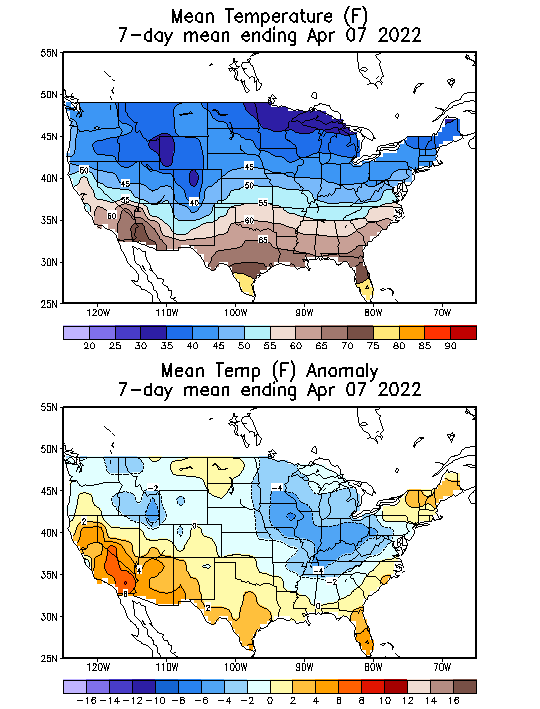
Source: National Oceanic and Atmospheric Administration Note: Image is not available.
Deviation between average and normal (°F)
7-day mean ending Apr 07, 2022

Source: National Oceanic and Atmospheric Administration Note: Image is not available.

